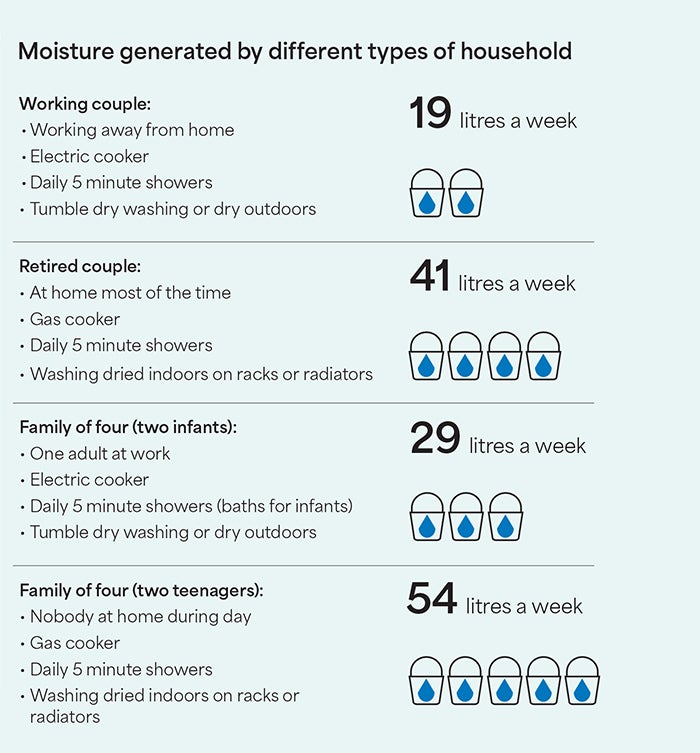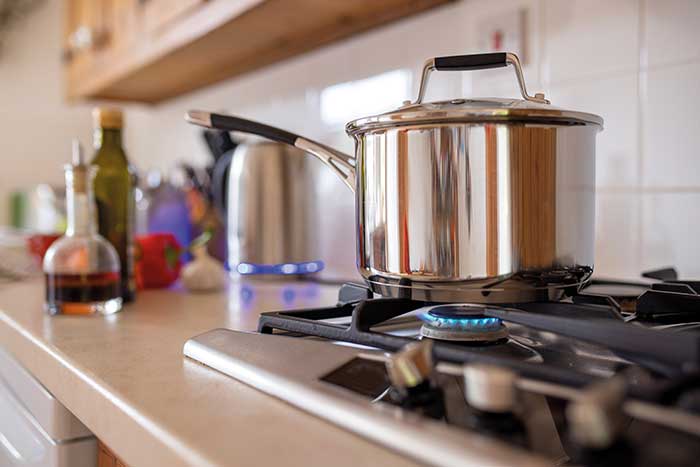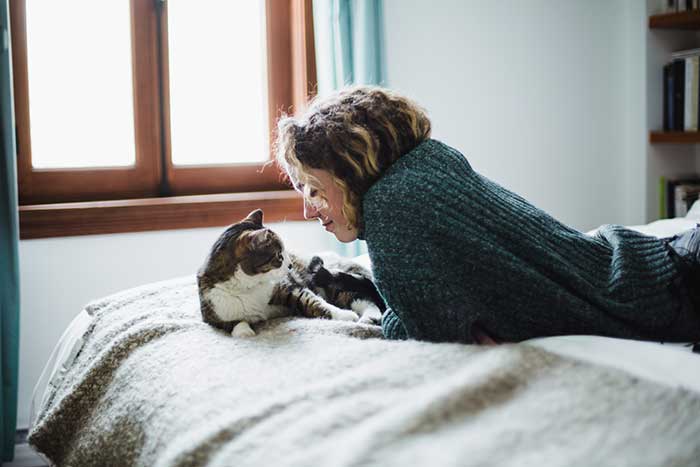Tips to avoid condensation, damp and mould
Worried about the cost of living?
Visit our dedicated page for helpful tips and support available
Your home should be a place you love to live – without worrying about damp or mould. On this page, you’ll find tips on how to prevent condensation in your home, and information on how we can help if you have more of a problem.
It’s important that you let us know, so we can help identify the underlying causes and what action can be taken.
Learn more about condensation, mould and how we can help
There’s always moisture in the air, even if you can’t see it. Most moisture in your home is created by everyday activities like washing, cooking, bathing – even breathing.
If water stays as a gas in the air, there will be no problems with condensation. But air needs to stay warm to hold on to water in its gas form.
Condensation occurs when water in the air turns into liquid water on a colder surface. It is most likely to appear on windows, colder parts of walls, around external door and window frames and where ceilings and floors meet with outer walls.
It can also appear where air circulation is restricted (such as inside cupboards or behind furniture placed against an outside wall).
As warmer air holds moisture better, a colder home will also release more moisture to these surfaces.
Condensation is also formed in new homes as the materials used in constructing them (such as mortar and plaster) dry out gently over time.

If condensation from too much moisture in the air forms regularly on cold surfaces and it isn’t wiped away or able to escape outside, it can sometimes provide the right conditions for black mould to grow.
Mould only grows on clean water (the condensation) and commonly appears in bathrooms and kitchens, where we tend to produce more moisture.
It can also appear in other areas which are more prone to condensation because of cold surfaces: windows, colder parts of walls, around external door and window frames, where ceilings and floors meet with outer walls, inside cupboards or behind furniture - or even on bedding and clothing.
Reducing excess moisture in your home will reduce the risk of condensation mould.
Mould can be a risk to your health and cause damage to your home, so it’s important to deal with it as soon as possible. Breathing large quantities of mould spores can cause health problems, particularly if you have asthma or other health issues.
As well as taking action to treat any existing mould, there are lots of ways to minimise and manage condensation to avoid future problems. This includes getting the best out of your heating (including thermostats and programmers), windows, fans and ventilation systems.
Excess condensation
Condensation isn’t normally a building fault but, if you’ve tried to reduce the moisture in your home and it’s not working, or if you have a problem with severe condensation or mould, please ring us on 0300 5000 926.
If you have excess condensation, we can help. Simple things like fitting trickle vents in your windows for constant air flow, or installing extractor fans in your kitchen and bathroom, can make a big difference. We will also be able to carry out a mould wash.
Types of damp
In other cases, damp could be causing the problem and, if it’s an issue with the building, we will put it right.
There are several types of damp and they each have different causes:
Penetrating damp is caused by water seeping through the walls, often due to a leak or faulty roofing. If you think your home may have penetrating damp, we’re here to help – let us know as soon as you can, so we can arrange a home visit and find the right solution.
Very rarely, rising damp may be the problem. It causes a ‘tide mark’ (or horizontal line) to travel up your wall. This means that groundwater could be getting in, usually due to a damaged damp proof course. If you think you have rising damp, don’t worry – contact us as soon as you can, and we’ll investigate it for you and work quickly to resolve things.
If you’re a home owner, shared owner or leaseholder, you’re normally responsible for the repairs and maintenance of your home but please speak to us in case any problems are due to a structural issue that we’re responsible for.
If you rent a home from us, we’ve introduced a new approach so that we treat any report of condensation, damp and mould as a priority repair.
- We’ll ask you about the extent and location of any issues – and our advisors will also ask you to send us photos of the problem areas.
- We’ll work with you to arrange a convenient time to visit your home to assess the situation. We may complete this assessment on a video call.
- We’ll aim to visit to do an assessment, and any initial works, within 10 working days.
- We’ll then discuss any one-off or ongoing treatment that may be required.
Depending on the severity, one of our team will also do a follow-up call or visit within three months to make sure that the problem has not reoccurred.
If excess condensation is the problem, this page includes lots of tips to reduce this and help keep your home mould-free.
However, if mould does occur, you should treat it straight away to stop it from spreading and causing more damage.
- Sterilise the affected area with a suitable fungicidal wash (available from most DIY stores and some supermarkets). Follow the manufacturer’s instructions carefully, particularly any health and safety notes.
- Keep checking the affected area for at least a week. If the mould reappears, wash it down again with the fungicidal wash to make sure the area is thoroughly sterilised.
- If mould or mildew is growing on clothing or carpets, you should dry clean them.
- Don’t brush or vacuum up mould, as this can increase the number of mould spores in the air and the risk of respiratory problems.
- If the treatment appears to be successful, you can carry out any necessary redecorating. If you’re painting, use a good quality fungicidal paint (available from most DIY stores) to help prevent mould appearing again. Remember this won’t be effective if it’s later covered by ordinary paint or wallpaper.
- If you’re wallpapering, use a paste containing a fungicide to prevent further mould growth, but don’t use wallpaper in a bathroom.
- To prevent mould returning, you also need to keep controlling the condensation in your home.
You may not avoid condensation in your home entirely but there are lots of ways to manage it and make sure it doesn’t cause problems. The advice below should help.
Tips to reduce moisture and condensation in your home

- Put lids on saucepans when you cook, to reduce the steam.
- When you’re running a bath, put cold water in first then add hot – it reduces steam by 90%.
- If you use a vented tumble dryer, make sure it’s properly vented to an open window or through an outside wall.
- Wet clothing is one of the biggest sources of moisture in the home. It’s better to dry clothes outside if you can but that’s not always possible if it’s raining or you don’t have access to outside space.
- If you need to dry clothes indoors, it’s best to use a clothes airer: drying them on a radiator is the worst thing you can do in terms of managing condensation mould as this creates a lot of very moist air very quickly.
- The bathroom is usually the best ventilated room for drying clothes (an airer rack that fits over the bath is a good idea in a small flat). If your bathroom doesn’t have a fan, open the window slightly and keep the door closed – so that the moisture can escape outside not circulate around your home.
- If your bathroom doesn’t have a window, the kitchen is another option for drying clothes, as long as it’s warm, has some trickle ventilation and you keep the door closed.
- Check if you need to leave the light on to keep any bathroom or kitchen fan running if it’s not activated by a humidity control.
- If you don’t have a fan in your bathroom or kitchen, we may be able to fit one to help improve the ventilation.
- Bedrooms are generally the worst place to dry clothes as the heating is less likely to be in the right cycle and we breathe out moisture overnight, which adds to the moisture from the clothes.
- Please note that we don't allow portable gas or paraffin heaters in our homes for health and safety reasons. These also produce a lot of moisture.
- Catch excess moisture by buying small disposable condensation traps for problem windows or other areas. These contain absorbent crystals and only cost a £1 or two. While they aren’t a complete answer, they may help. For an even cheaper DIY version, try a bowl of rock salt on the windowsill or an old sock filled with cat litter. (Replace these when damp.)
If you’re creating moisture in the air but it can’t escape through a window or air vent, it will move around until it finds a cold surface where it will cool and form condensation. So ventilating your home effectively is a key part of living in it.
Modern homes are also built with lots more insulation and draughtproofing. That’s great to reduce wasted energy but also means it’s particularly important to use any additional ventilation features.
Brand new homes also need more ventilation while they’re drying out.

- If you see condensation forming, wipe it away with a clean dry cloth (wring this out afterwards) and open the window or use an extractor fan to help let the moisture out.
- Open windows briefly when you get up in the morning, to bring in some drier air from outside and let moisture escape after it’s built up from your breathing overnight.
- Open the window or use an extractor fan before you start cooking or have a bath or shower. Keep the door closed to stop moisture moving to other rooms. In winter this isn’t about ‘airing’ your home for hours and getting cold: just for 20 minutes or so to let the moisture disperse.
- Never isolate (turn off) an extractor fan as the moisture from showers, baths and cooking will stay trapped in your home.
- Keep window trickle vents
(slotted vents in the window frame) open when you’re in the room, even in the winter when your heating is on. These provide a very small amount of constant ventilation to let dry air in and moist air out.
- Keep other vents open and clear.
- If your home has a positive input ventilation (PIV) unit
, such as a Vent-Axia PoziDry Pro unit, this is designed to run automatically. It draws in drier fresh air, filtering and warming it to replace moist unhealthy air in your home. These units are very quiet, energy-efficient and only cost a couple of pence a day to run but reduce the excess moisture that leads to condensation and mould.
- Newer properties may have a mechanical ventilation heat recovery (MVHR) system: a whole home ventilation system that extracts stale air and brings in fresh, filtered air. Please read the user manual and follow any guidance to understand how the system works, so that you can run your home effectively. Please contact us if you need more advice on this.
- If you can, put free-standing wardrobes and other furniture against internal walls and leave a gap of about two inches between the furniture and wall, so air can circulate around the room.
- Try not to put too many things in cupboards, wardrobes and drawers so that air can circulate around the contents.
- Try not to leave clothing or bedding in the corners of rooms.
Heat is key to managing condensation. The trick is making sure your home is ready for when you become active: first thing in the morning or when you’re coming home from work, school and so on. Otherwise, when you start showering, cooking or washing, you’ll create moist air which will settle on the cold surfaces and create condensation.

- Keep your home warm to avoid cold surfaces and remember that it can take a long time for a building to warm up.
- Depending on your household heating system, consider setting your heating to come on about an hour before everyone gets out of bed and go off as they get up – waiting until you get up and then switching it on manually is too late.
- If you’re not in during the day, set the timer so that your home is warm by the time you return.
- During very cold weather it’s better to leave the heating on during the day to maintain an even temperature. You can set the temperature a few degrees lower when you’re out and turn it up when you get back.*
- If you don’t usually use all the rooms in your home, you should still keep them heated to avoid cold areas. It’s better to keep all rooms heated to a low temperature than to have some rooms heated to a high temperature while others have the heating turned off. (If you try to warm an unheated room by leaving the door open to a heated one, warm air will just enter and condense on cold surfaces.)
- If you no longer need all the bedrooms in your home, please contact us as we may be able to help you move to somewhere smaller that is cheaper to heat.
- You may also notice some moisture on the felt beneath your roof tiles in cold weather as warm moist air settles on cold surfaces like the felt and roof timbers. As the roof space is ventilated or breathable, this should usually disperse gradually without any problems but please contact us if you are concerned. Following the general tips on reducing condensation will also help reduce the amount of moist air.
- Conserving more heat can also help to keep costs down. Pulling your curtains as it starts to get dark can reduce heat loss by 15-17% say researchers at a scientific ‘Energy House’ in Salford. Draught excluders in front of doors are also a cheap and effective way to retain heat.
We understand it's not always possible to heat your home as much as you'd like. Please check out the other information on this page about sources of support and advice if you need them.
*The government suggests keeping your living areas at 18-20 degrees when you're at home (bedrooms can be a bit cooler at night). To avoid major condensation problems, the temperature shouldn’t drop below 14 degrees.
If you’ve tried to reduce the moisture in your home and it’s not working, or if you have a problem with severe condensation or mould, please ring us on 0300 5000 926. We’ll do all we can to help.
Explore more sources of advice and support below...
Cost of living support
We know that fuel bills and the cost of living can be a worry. We have various free services and advice on the support and discounts available nationally and locally, plus lots of money saving tips.
Money, guidance and debt support
Worried about debt, benefits or paying your bills and rent? Get support from our Customer Income Advisors and Debt Advice team or visit our webpage to find out more about how we can help.
Employment and skills
Our Employment and Skills team offer a personalised service of guidance, support and practical help to access training, work or better work.
Digital inclusion
Struggling to get access online, need help with digital devices, or interested in free online learning to improve your digital skills? Find out how our Digital Inclusion team can help.
Maintenance guides
Useful guides and videos on looking after your home - such as how to avoid frozen pipes, unblock a sink or what to do if your heating’s not working.
Contact us
We want to make it simple for you to contact us, which is why we offer a variety of ways to get in touch.
